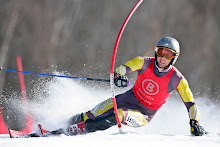The USSA Congress is absolutely nuts. It’s 5 days of back-to-back-to-back meetings that addresses every conceivable area of the sport of ski racing, from the width of a slalom pole (and the designation that it shouldn’t be referred as a gate) to the size of the collegiate quota for US Nationals if the NCAA champion doesn’t attend to disciplinary actions if an athlete at a USSA-affiliated camp uses marijuana in a state like Washington or Colorado after it is legalized (sorry hippies, it’s still a no-no) to my personal favorite, a request for more involvement with ski racing with Big Ten schools. I’m envisioning a night slalom in the Big House now...Add in the equally, if not more, important meetings and meals with the constituency, USSA coaches and officials, trustees, college coaches, etc., and it makes for a very involved couple of days. In all, the Congress was a fantastic experience and I think it was useful in creating policy to shape ski racing in the US in a more positive way.
Monday, May 20, 2013
Hammertime at the Congress
Working with Chip Knight and Gina Gassman, the athlete reps to the USOC and USSA, respectively, we staffed many of the committees to hit the minimum 20% requirement of athlete representation as mandated by the Ted Stevens Amateur Athletic Act. I am now formally an athlete rep to following alpine committees: Executive Committee, Development and Education Subcommittee, Collegiate Working Group, Quotas and Selections Committee, and Judicial Committee. I’m told this is a lot of work, but each of these subcommittees is important, and I can’t think of one that I shouldn't be on. Besides, I sat in on each of these committees this year, many of them had 2 or even three sessions, so if I didn’t collapse this time then might as well keep chugging!
Also, it has been recommended that there be athlete representation on each regional board. The current alpine athlete reps and I have been asked to submit recommendations to the USSA to fill out these positions (we might even choose them, it’s yet to be determined). I think the idea of athlete involvement on the regional level is a great one, and necessary to ensure that the end-user of the product of USSA ski racing is being considered in every decision making process. One only needs to have competed in the last 10 years to be eligible, so I encourage any and everyone who takes the future of their sport seriously to contact me (charleschristianson@gmail.com
One of the best parts about the Congress was the amount of engagement that the USSA officials expressed and wanted to have with myself and the other athlete reps. Scott Macartney said it best when he stated, “there is no ‘man behind the curtain’ at the USSA.” That is not to say that I agree with all of the policies of the USSA, we certainly have more work to do in a lot of areas, but I never experienced a moment where the opportunity to engage the appropriate people wasn’t available. Luke Bodensteiner, USSA Executive Vice President of Athletics, was very helpful in directing me toward which parties would best handle each concern that I brought forth on behalf of the athletes. Through this I addressed certain issues off-line, like billing practices for unfunded USST athletes, creating opportunities for collegiate skiers to train with the Team, and putting in requests to expand quotas to certain European January races that are historically oversubscribed.
In terms of formal motions put forth during the Congress, it was fitting that Gina and I sponsored a motion to support a student USSA license for USCSA athletes, specifically, "to support Student License with USSA and collegiate head tax component program for affordable collegiate ski racing”. The USCSA, a group of 178 colleges across the country boasting a 4,700 member group of largely self-organized, funded, and coached collegiate ski racers and snowboarders, left the USSA last year after a shift in the head-tax policy increased costs by a factor of 3-4 for each team in an effort not to price the teams out the sport. I, along with many others, believe that our sport’s national governing body is most complete when it represents all groups of the ski racing groups in this country. The task force charged with deploying the findings of the McKinsey report is going to take on assessing the viability of this proposed USSA license tier, from the cost structure to the access that this type of license will provide. I look forward to learning these findings and moving one step closer toward including the USCSA back under the umbrella of the USSA.
I want to thank everyone who helped me get up to speed and allowing me to be a more effective athlete rep than I otherwise would be. It was great to learn that many issues can be discussed in an open and productive setting, and I look forward to more opportunities to represent the athlete’s voice in these discussions. Time to do some serious follow up!
Posted by Charles Christianson at 7:53 AM
Subscribe to:
Post Comments (Atom)


0 comments:
Post a Comment